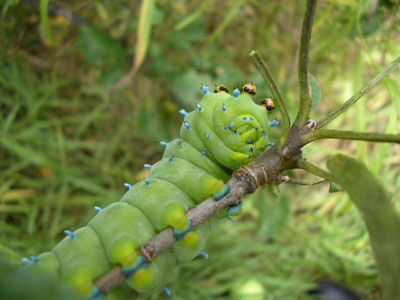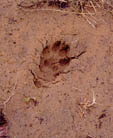Every now and then I come up against evidence suggesting that I'm not as fluent in my native tongue (English) as I thought. Chrysalis? Cocoon? I don't know. So I looked them up in the Oxford Canadian Dictionary:
cocoon: a silky case spun by many insect larvae for protection as pupae
chrysalis: a quiescent pupa of a butterfly or moth; the hard outer case enclosing it
Which didn't help all that much. The silky covering of the one in the yard is tough, but maybe not very hard--so I'll go with cocoon. The case that surrounds the Monarch pupa certainly looks hard--so, chrysalis?
 Cocoon, April 28, 2007
Cocoon, April 28, 2007During the winter I could see this from the back window, and for a long time thought it was a bird's nest. It's just about 10 cm (4") long. The spirea (flowering shrub, very common in gardens around here) it's in has pretty dense foliage at its peak, so it was not unreasonable to suppose that a bird could've nested there without me noticing. Song sparrows nest all over the place, and I usually can't really pinpoint their locations. Of course, I don't really try--it's rarely a good thing to locate a nest--it either puts it at risk, or it indicates that it isn't well located, i.e., already precarious. Anyway, inspection early in the spring revealed that this was no nest.
It's the cocoon of something big. We had some big stuff around last summer that I know about--and then there are all the things I never saw.... I put this on
BugGuide.net this morning just in case it can be identified by size and/or location. I check on the cocoon three or four times a day, but still no sign of any change. After a hot week the weather has cooled considerably, so I wonder whether these guys can hold off if conditions aren't great, or if once they get on a certain timetable they can't get off. I'm taking off for a few days next week and I'd hate to miss the emergence.
Here's a link to some photos of an emerging moth of the family that I suspect is represented here, that were pointed out to me in the first response to my id request:
Antheraea polyphemus. Mere moments later I got another response, identifying my cocoon as a probable
Hyalophora cecropia, based on the relatively open weave. I love
BugGuide.net (here's a
link to my id request and the responses). I have always had extremely quick and helpful responses from that bug community. And cecropia fits--it is certainly well represented around here in the caterpillar season.
Update (later the same day): Because the shape of this cocoon is unlike the other examples of cecropia cocoons at BugGuide, there is uncertainty over the identification. Check
the page to see why. And I'll post updates as they develop.
Update #2--next morning: Okay, the issue is resolved. Apparently
Hyalophora cecropia shows up in two different kinds of cocoons--neat, narrow ones, and big baggy ones (such as mine). So Robin moth it is--very nice. I've got my fingers crossed that I actually get to see one of these beauties. For more about the moth, check out its
species page at BugGuide.
And just one more: Here's a link provided by Bev of
Burning Silo in the comments below, to
another good site for cecropia info.
Here's
a post I wrote last August about the cecropia caterpillar pictured below. Apparently the adult moths only live a couple of weeks, so all the more I hope I get to see this one emerge!

Hyalophora Cecropia,
August 2006










